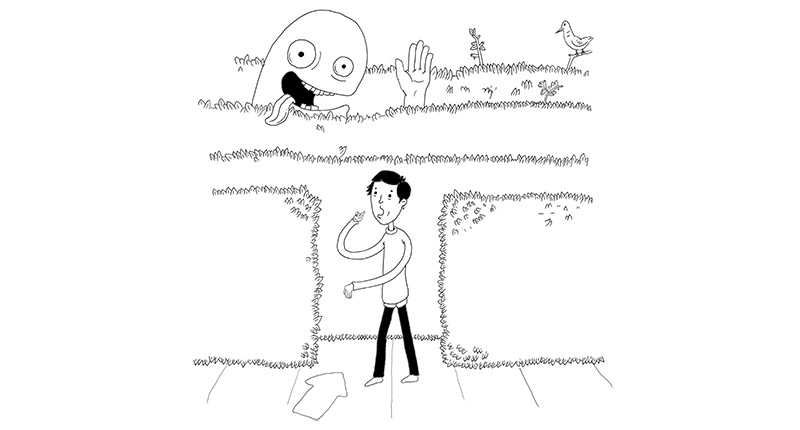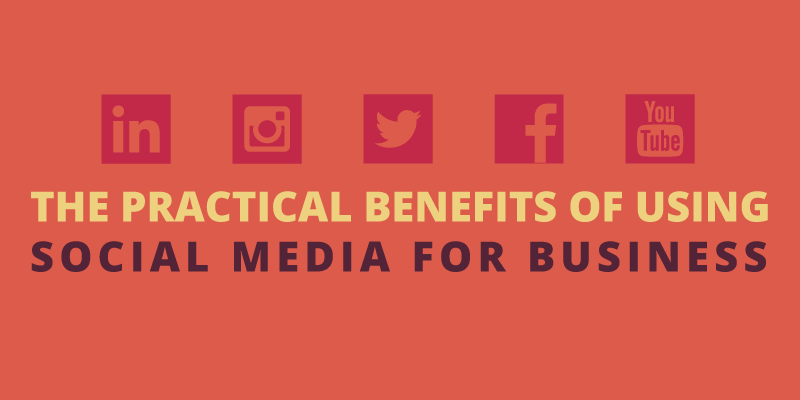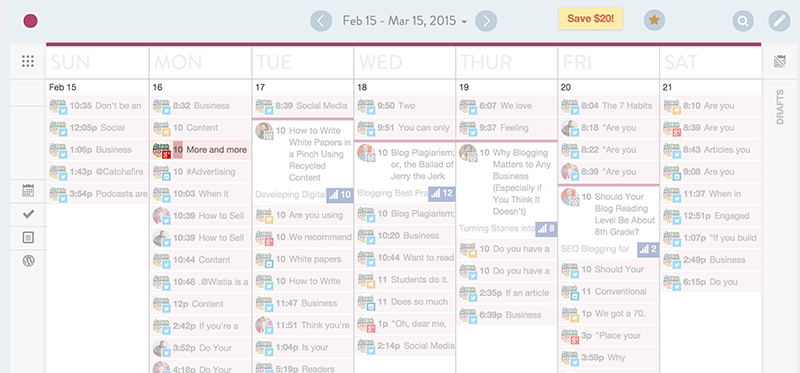If you’re not using some type of social media testing, you’re not paying attention.
Some companies are just plain good at social media – or are they? For companies using social media, testing should be a crucial component of an overall strategy. This shouldn’t be a surprise to you.
I would even argue that, among other things, it’s the testing that makes them so great. In the music world, we might call this rehearsal, or in sports maybe you would refer to this as your playbook.
But what can you learn from testing? Aside from everything? Ok, how about this: common practice for Facebook posts is to keep it short. Your reader needs to be able to read your post while they are skimming. Not so.
Our social media testing counters this advice. In the case of one client, we’ve seen Facebook shares double and triple when we post longer article excerpts. Now, this could just be this particular audience, but we would have never known this without an A/B test.
And you know what’s great about social media testing? It really only takes a day or so to get your answers. And, it doesn’t cost you any extra.
Social media testing saves you money
That’s right! It only takes a little bit of time to run a content test on your social media channels. It doesn’t cost you any extra money, and you might just find ideas and campaigns that you can transfer to print or digital ads. You could even save money.
Think of it this way; Bud Light’s recent “removing no from your vocabulary for the night” tagline was just terrible. The backlash from this line and the corresponding hashtag #upforwhatever was instant and merciless – and deserved.
Social media testing for this ad may have saved them tons of money. Instead, they spent probably millions on television ads and bottle branding. They could have averted a PR and financial debacle if only they had tested first. Except for one thing…
The did in fact test the hashtag during St. Patrick’s Day, and were consequently castigated for being oblivious to the problems of violence against women. I cannot imagine why it seemed like a good idea to continue on that path. Clearly, social media testing isn’t foolproof, but I feel sure you can do better than Bud Light.
[Tweet “But what can your business learn from #socialmedia testing? Aside from everything?”]What you can learn from social media testing
The social media testing ground is a perfect place to learn how customers view your business, and to find out what they are looking for. Basic tracking of your campaigns lets you know what resonates with your audience, and what doesn’t.
I was curious to know how other businesses use the medium to tailor their approach, so I reached out to social media and marketing professionals to find out what they have found through the social media testing. Here’s what I found out.
How social media testing works
It could be A/B testing or just tracking the engagement from your posts. No matter which social media platforms you use, the same idea applies. Try something, and see what happens. Use your results to tweak your strategy, then repeat.
“By making various social media posts, you start to see the type of headline messaging and imagery that generates a lot of interaction amongst your customers. This helps me put together advertisements and marketing campaigns.” – Jason Parks, Owner, The Media Captain
“Our target demographic is college students, so when we began, we were posting broad topics on college student life to see what stuck. Initially, we believed that the more pop-culture posts would give us the highest CTR, but as time went on we realized our most successful posts were geared towards students and their upcoming professional life.” – Rachel Collins, Chief Marketing Officer, Danny Group, LLC
“When something is not working, even when something small is off, your customers are the front line in finding these issues.” – Jeremy Levy, Director of Marketing, Cardcash
“We post a lot of articles from a variety of sources and it’s very easy to see which article topics get the most engagement. We can then tailor our content to those topics.” – Louise Hendon, Co-Founder, Paleo Living Magazine
“Through social media, our students provide us with real-time feedback on website changes, updates to the program, and how they felt they did on their final exams. All of this feedback allows us to tweak our program to provide the ultimate customer experience.” – Rachael Nichol, Online Marketing Specialist, American Board
Social behavior is necessary and useful
It’s not just the testing that will help you find your way on the social media path. Be aware of the behavior and lifestyles of your audience. What do they want, or more precisely, what benefit do they get from following you? Or in marketing parlance, know your target audience.
Awareness will help you understand what you are doing right, or what you should be doing to engage your audience more effectively.
[Tweet “If you’re not using some type of social media testing, you’re not paying attention.”]“I learned that customers are better at social media than most professionals. We, professionals, have all the knowledge and science behind why everything should be a certain way, but customers are raw and uncut and we forget that’s what the world wants.” – Sharon Gadbois, Social Marketing Leader & Business Strategist, Gadbois Consulting Group
“The best thing that we have learned about our customers from social media is that they routinely advocate for our business in their professional and philanthropic endeavors. With most new contracts, we learn that someone on the identification committee is connected to our social media pages and recommended our business to be considered for the opportunity.” – Crystal L Kendrick, President, The Voice of Your Customer
“The best thing I’ve learned about my customers through social media is what time of day they’re active on social media. Paying attention to when the most “likes, retweets and comments” come in, has helped me to be strategic with being there at the same time to respond and engage in conversation.” – Angel Tuccy, Host of The Experience Pros Radio Show, Experience Pros
“By monitoring what our clients are saying on social media, we can get a glimpse of what they are dealing with on a day-to-day basis, and what business trends and issues matter the most to them. It’s a great channel for getting customer insights into what they care about.” – Erika Goldwater, VP of Marketing, Annuitas
“We’re constantly using Facebook to seek information from our audience. This type of information is very valuable to not only our clients but it promotes an online forum for our fans to see what others are interested in and talking about.” – Elizabeth Ryder, Director of Social Media, Gossip Genie
“For me I think it comes down to understanding my customers as people and not simply as customers and numbers. Understanding their life structure is huge and allows me to better personalize the service that I may offer them.” – Christopher Arnell, Director of Solutions, The Whitley Group
“People want content that engages them and helps them and makes them feel like an expert to their social friends. I have learned that my followers likes value; a tip they can share, a checklist they can download, information that helps their lives.” – Lisa Baker-King, Family Author, Coach & Small Business Expert, LBK Kreatives
“We are able to learn about what our customers love/hate, how they talk about and describe our products and services, what blog posts they read and share most and what problems they are having.” – Emmelie De La Cruz, Social Media Marketing Manager, SumAll
“Taking the time to actually monitor what your audience is reading about, tweeting about, and posting about gives you some crucial insight as to what they want out of their social media experience. With that information, you can clearly and effectively tailor your social media around these wants and needs.” – Jacki Bubis, PR and Social Media Associate, Modern Graffiti Marketing Agency
From social media testing to real life testing
Some companies take the social media testing and awareness to the next level. While this certainly isn’t necessary, it is a beautiful gesture if you have the resources, or if you feel like it is a good investment. I’ve seen this take place in the form of contests, invitations, games, but for goodness’ sake, please don’t engage in those blatant attempts to increase followers with the “share this to win” type games.
“Social has been a great way for me to identify my brand’s champions. I’m inviting those customers who really stand out to me to join an email list that will allow me to ask them their thoughts on future designs, what’s working and not working, and offer them special things in gratitude for their support of my brand. Because I’ve very purposely chosen to be transparent and vulnerable, they’re more willing to share and cheer me on.” – Amy Jones, Cartographer, Map Your Progress
Now that’s customer engagement! You’ve probably seen this in some form or another. Restaurants may invite you in for a free drink or dinner with a social media contest, or the local construction company might offer a free appraisal. The possibilities are truly only limited by your imagination. Just make sure your offer is genuine.
Let’s add it up
Ok, so you’re ready to take your social media game up a notch? Yes? Good. Let’s do this.
- Determine your goal for social media testing. There are a lot of worthwhile objectives, but it’s best to stick to one test at a time. The more you can limit the variables, the more reliable your results will be. What do you want to know about your audience? What time of day are they on social media? Is there a hashtag they respond to? Do they engage with questions?
- Set up your test. Let’s say I want to find out if my audience likes dogs or cats better. I could just ask a straightforward question. Maybe I run two posts back to back: one that says, “Do you like dogs?” and one that says, “Do you like cats?” Just make sure there are as few variables as possible. Don’t add a picture of a cat to the cat post and no picture to the dog post – those are two different types of posts.
- Examine the results. Did your dog post get more response? Ok, then it’s time to tweak the results. Now run two back to back posts that say “I love dogs” and use a hashtag in one. “I love dogs” vs. “I love #dogs.” What gets more engagement?
- Repeat. Continue this cycle until you find out what works best. Maybe you run two posts that say “I love #dogs” but one of them has a photo, and the other doesn’t. Take that winner and post the exact same post at two different times of day. Gradually eliminate variables until you figure out what works best.
- Repeat again. For real. You figured out what works! Congratulations! Now do it again, because you never know when your audience will change, or what may start to trend and surprise you. Don’t disregard your previous results. Just don’t assume your results are good forever.
Does this all seem like a bit much? We love testing and analytics ’cause we’re just wired that way. Get in touch to find out how we can help you.
Do you test your social media? What have you found that works best? Let us know in the comments.











